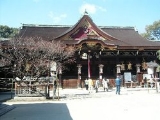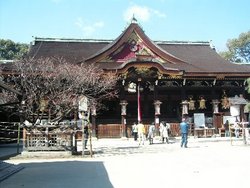
Kitano Tenman-gu
Encyclopedia
is a Shinto shrine in Kamigyō-ku, Kyoto
, Japan
.

 It was built in 947
It was built in 947
, to appease the angry spirit of bureaucrat, scholar and poet Sugawara no Michizane
, who had been exiled as a result of political maneuvers of his enemies in the Fujiwara clan.
The shrine became the object of Imperial patronage during the early Heian period
. In 965, Emperor Murakami
ordered that Imperial messengers be sent to report important events to the guardian kami
of Japan. These messenger, called heihaku, were initially presented to 16 shrines; and in 991, Emperor Ichijō
added three more shrines to Murakami's list — including Kitano.
From 1871 through 1946, the Kitano Tenman-gū was officially designated one of the , meaning that it stood in the second rank of government supported shrines.
, the scholar-bureaucrat was deified and the title of Tenjin (Heavenly Deity)
was conferred.
The grounds are filled with Michizane's favorite tree, the red and white ume
or plum blossom, and when they blossom the shrine is often very crowded. The Plum Blossom Festival (梅花祭, baikasai) is held on February 25, coinciding with the monthly market. An open-air tea ceremony (野点, nodate) is hosted by geiko
and apprentice maiko from the nearby Kamishichiken
district, where tea and wagashi
are served to 3,000 guests by geisha and maiko. The plum festival has been held on the same day every year for about 900 years to mark the death of Michizane. The outdoor tea ceremony dates back to 1952. In that year, a big festival was held to mark the 1,050th anniversary of Michizane's death, based on the historic Kitano Ochakai tea ceremony hosted at the shrine by Toyotomi Hideyoshi
.
Kitano Tenmangū is popular with students praying for success in exams because the deity was in his life a man of literature and knowledge. On the 25th of every month, the shrine hosts a flea market
. Together with the similar festival at Tō-ji
, a temple in the same city, they inspired the Kyoto proverb, "Fair weather at the Tōji market means rainy weather at the Tenjin market," calling to mind Kyoto's fickle weather.
Kamigyo-ku, Kyoto
is one of the eleven wards in the city of Kyoto, in Kyoto Prefecture, Japan. Located in the center of the present-day city of Kyoto, Japan it previously occupied the northern region of the ancient capital of Kyoto. The Kamo River flows on the eastern border of the ward...
, Japan
Japan
Japan is an island nation in East Asia. Located in the Pacific Ocean, it lies to the east of the Sea of Japan, China, North Korea, South Korea and Russia, stretching from the Sea of Okhotsk in the north to the East China Sea and Taiwan in the south...
.
History


947
Year 947 was a common year starting on Friday of the Julian calendar.- Asia :* The Later Jin Dynasty falls to the Later Han Dynasty in China....
, to appease the angry spirit of bureaucrat, scholar and poet Sugawara no Michizane
Sugawara no Michizane
, also known as Kan Shōjō , a grandson of Sugawara no Kiyotomo , was a scholar, poet, and politician of the Heian Period of Japan...
, who had been exiled as a result of political maneuvers of his enemies in the Fujiwara clan.
The shrine became the object of Imperial patronage during the early Heian period
Heian period
The is the last division of classical Japanese history, running from 794 to 1185. The period is named after the capital city of Heian-kyō, or modern Kyōto. It is the period in Japanese history when Buddhism, Taoism and other Chinese influences were at their height...
. In 965, Emperor Murakami
Emperor Murakami
was the 62nd emperor of Japan, according to the traditional order of succession.Murakami's reign spanned the years from 946 to his death in 967.-Traditional narrative:...
ordered that Imperial messengers be sent to report important events to the guardian kami
Kami
is the Japanese word for the spirits, natural forces, or essence in the Shinto faith. Although the word is sometimes translated as "god" or "deity", some Shinto scholars argue that such a translation can cause a misunderstanding of the term...
of Japan. These messenger, called heihaku, were initially presented to 16 shrines; and in 991, Emperor Ichijō
Emperor Ichijo
was the 66th emperor of Japan, according to the traditional order of succession.Ichijō's reign spanned the years from 986 to 1011.-Traditional narrative:Before he ascended to the Chrysanthemum Throne, his personal name was Kanehito-shinnō....
added three more shrines to Murakami's list — including Kitano.
From 1871 through 1946, the Kitano Tenman-gū was officially designated one of the , meaning that it stood in the second rank of government supported shrines.
Tenjin
The shrine was dedicated to Michizane; and in 986986
Year 986 was a common year starting on Friday of the Julian calendar.- Europe :* March 2 – Louis V becomes King of the Franks....
, the scholar-bureaucrat was deified and the title of Tenjin (Heavenly Deity)
Tenjin (kami)
In Japanese mythology and folklore, is the Shinto kami of scholarship, the deification of a scholar, poet, and politician named Sugawara no Michizane. Ten means sky and jin means god or deity...
was conferred.
The grounds are filled with Michizane's favorite tree, the red and white ume
Ume
Prunus mume, with the common names including Chinese plum and Japanese apricot, is an Asian tree species classified in the Armeniaca section of the genus Prunus. The flower, long a beloved subject in the traditional painting of East Asia, is usually translated as plum blossom. This distinct tree...
or plum blossom, and when they blossom the shrine is often very crowded. The Plum Blossom Festival (梅花祭, baikasai) is held on February 25, coinciding with the monthly market. An open-air tea ceremony (野点, nodate) is hosted by geiko
Geisha
, Geiko or Geigi are traditional, female Japanese entertainers whose skills include performing various Japanese arts such as classical music and dance.-Terms:...
and apprentice maiko from the nearby Kamishichiken
Kamishichiken
is a district of Kyoto, Japan. It is the oldest hanamachi in northwest Kyoto, just east of the Kitano Tenman-gū Shrine. The name Kamishichiken literally means "Seven Upper Houses." These refer to the seven teahouses built from the equipment and material leftover from the rebuilding of the Kitano...
district, where tea and wagashi
Wagashi
is a traditional Japanese confectionery which is often served with tea, especially the types made of mochi, azuki bean paste, and fruits.Wagashi is typically made from natural ingredients...
are served to 3,000 guests by geisha and maiko. The plum festival has been held on the same day every year for about 900 years to mark the death of Michizane. The outdoor tea ceremony dates back to 1952. In that year, a big festival was held to mark the 1,050th anniversary of Michizane's death, based on the historic Kitano Ochakai tea ceremony hosted at the shrine by Toyotomi Hideyoshi
Toyotomi Hideyoshi
was a daimyo warrior, general and politician of the Sengoku period. He unified the political factions of Japan. He succeeded his former liege lord, Oda Nobunaga, and brought an end to the Sengoku period. The period of his rule is often called the Momoyama period, named after Hideyoshi's castle...
.
Kitano Tenmangū is popular with students praying for success in exams because the deity was in his life a man of literature and knowledge. On the 25th of every month, the shrine hosts a flea market
Flea market
A flea market or swap meet is a type of bazaar where inexpensive or secondhand goods are sold or bartered. It may be indoors, such as in a warehouse or school gymnasium; or it may be outdoors, such as in a field or under a tent...
. Together with the similar festival at Tō-ji
To-ji
is a Buddhist temple of the Shingon sect in Kyoto, Japan. Its name means East Temple, and it once had a partner, Sai-ji . They stood alongside the Rashomon, the gate to the Heian capital. It is formally known as which indicates that it previously functioned as a temple providing protection for the...
, a temple in the same city, they inspired the Kyoto proverb, "Fair weather at the Tōji market means rainy weather at the Tenjin market," calling to mind Kyoto's fickle weather.
See also
- List of Shinto shrines
- Twenty-Two Shrines
- List of National Treasures of Japan (shrines)
- List of National Treasures of Japan (paintings)
- Modern system of ranked Shinto ShrinesModern system of ranked Shinto ShrinesThe The The (sometimes called simply , was an organizational aspect of the establishment of Japanese State Shinto. This system classified Shinto shrines as either official government shrines or "other" shrines...
External links
- Kitano Tenman-gū Official web page (In English)
- Kyoto Shimbun: Open-Air Tea Ceremony... (in English)

